Pros
Cons
Introduction
The D5434XXLS is a new entry in the high-end D5000 series from Swedish appliance maker Asko. If you think Sweden is only good for IKEA and ABBA, think again. This dishwasher looks and performs like a boss, even if it isn’t the quickest thing out there. But let’s face it, punctuality isn’t cool.
Front
{{section_header}}{{section.name}}{{/section_header}}
In your kitchen, the {{product.model}} functions almost like a shape-shifter, capable of being both inconspicuous and head-turning. The flashy displays are very modern-looking, but are positioned so as not to draw too much attention.
Our one complaint is the position of two screws at the base of the machine. In a certain light, they reflect off the door in a way that makes it look dented.
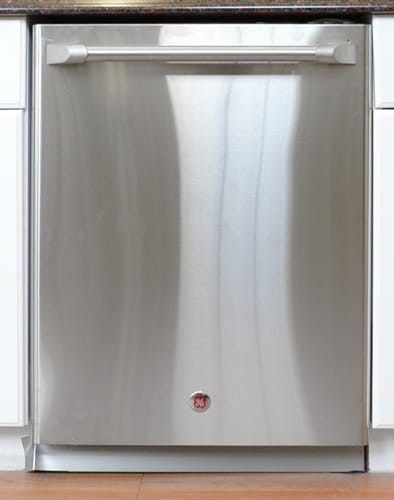
The front of the GE CDWT980VSS.
Finish
{{section_header}}{{section.name}}{{/section_header}}
The rest of the front is a blanket of stainless steel with an interior handle that reflects the machine’s overall quiet appearance.

Controls
{{section_header}}{{section.name}}{{/section_header}}
This control panel is one of our favorites. The buttons are touch-sensitive, the symbols tastefully designed, and the consoles round with a vaguely throwback flair. There’s also a written display of what each symbol means on the topside of the washer door.
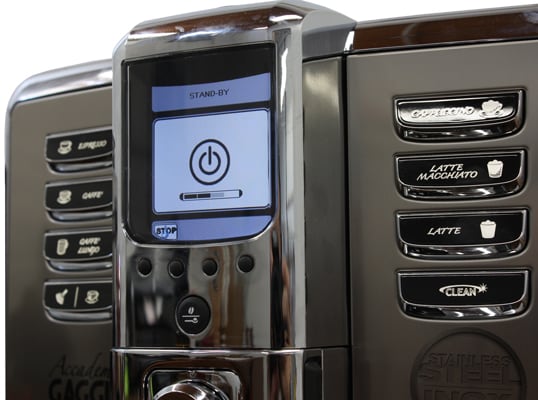
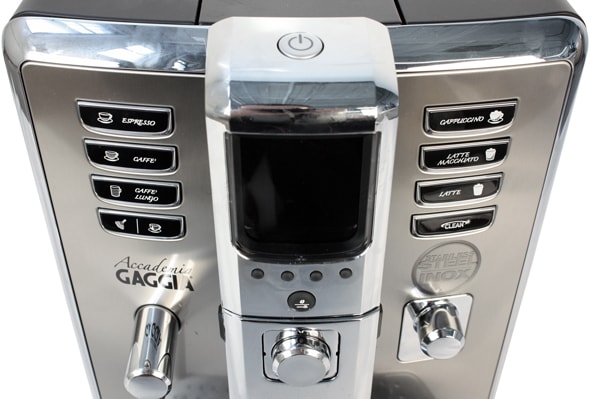
Interior
{{section_header}}{{section.name}}{{/section_header}}
The wash tub is stainless steel with metal wash arms beneath each rack.
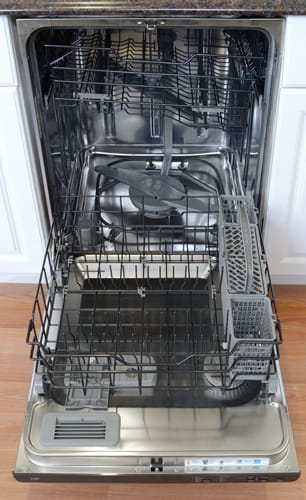
The CDWT980VSS with door open.
Top Rack
{{section_header}}{{section.name}}{{/section_header}}
The top rack has only two rows of tines, neither of which are foldable. However, the angle and abundance of the rack’s threads should keep most dishware firmly in place. This layout also makes for considerable flexibility when loading.
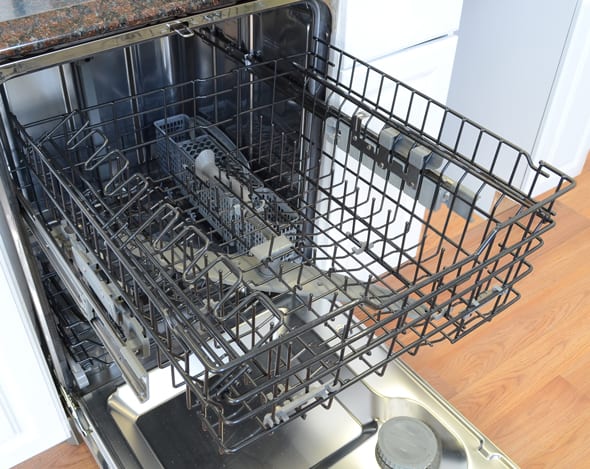
The top rack of the CDWT980VSS.
Bottom Rack
{{section_header}}{{section.name}}{{/section_header}}
Like the upper rack, the lower features a series of closely spaced threads to provide extra stability. There are six rows of angled tines, two of which are collapsible. There’s also an elevated handle for folks with bad backs.
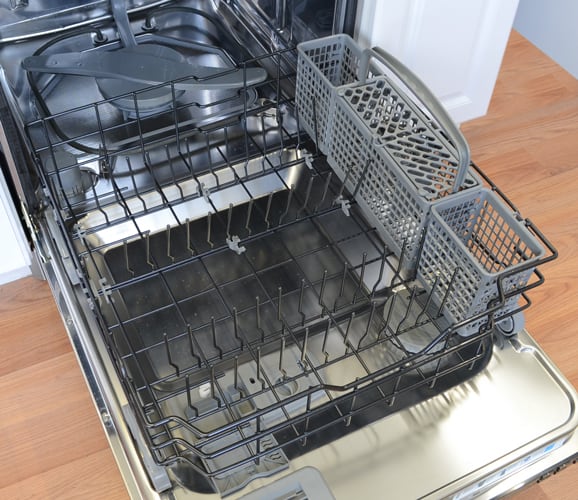
The bottom rack of the CDWT980VSS.
Cutlery Basket
{{section_header}}{{section.name}}{{/section_header}}
The cutlery basket has an almost comically large, angled handle. But some owners may appreciate this. It includes eight interior bays, four of which have dividers for additional storage needs, although these seem a bit excessive. Conveniently, the basket is designed to slide along the front two rows of tines for added flexibility when loading.
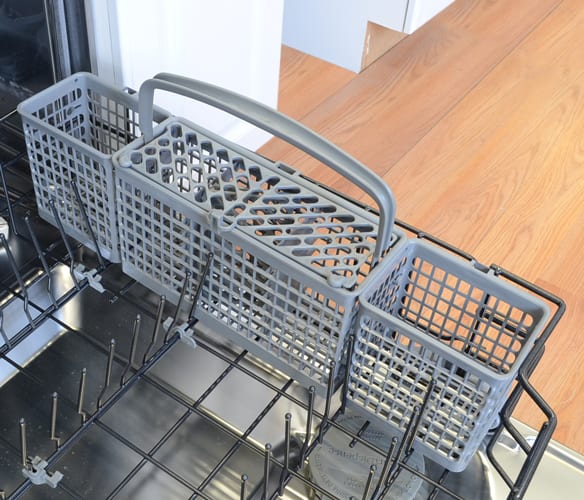
The CDWT980VSS cutlery basket.
Electricity Use
{{section_header}}{{section.name}}{{/section_header}}
The {{product.model}} consumes a considerable amount of energy—most of it for heating water—but not enough to plague your utility bill. Electricity consumption hovered around 1 kWh per wash, with the Quick Wash actually consuming more energy than the Normal Wash. This is likely due to its higher temperature cycle.
In all, power usage for the Quick Wash will cost about 10 cents per wash, compared to 9 cents on the Normal Wash and 12 cents on the Heavy Wash.
{{ attachments(50fc520abd0286904900082f)
Water Use
{{section_header}}{{section.name}}{{/section_header}}
{{product.brand.name}} recommends connecting the {{product.model}} to a hot water supply under only a few circumstances, so all of our tests were conducted with a cold water hookup. Most of what makes this machine so efficient stems from its water consumption, which is remarkably low.
We found the Quick Wash consumed an average 2.68 gallons of cold water per wash, the Normal Wash used 3.93 gallons, and the Heavy Wash 5.15. This makes for water cost of 1 to 2 cents per wash. Cool.
Yearly Running Cost
{{section_header}}{{section.name}}{{/section_header}}
These figures compute to an average operating cost of just $24.22 per year. This is based on an estimate of choosing the Regular Wash 50 percent of the time, with the remaining proportions split evenly between the Quick and Heavy Washes.
While this figure is extremely low compared to industry competitors, remember that the Asko D5434XLS is calm and collected; it sees no point in rushing its wash cycles or super heating its water supply. The result is a slow but efficient clean.
{{comparison_bars title="Yearly Running Cost", attribute="Yearly Running Cost", xLabel="Cost to run over a typical year ($)"}}
Washing Speed
{{section_header}}{{section.name}}{{/section_header}}
In summing up every single complaint we had about the {{product.name}}, this is probably the biggest. Yes, we understand that dishwashers must be meticulous to deliver high performance, but a three-and-a-half hour Heavy Wash? Oh, let me just go run a marathon before my dishwasher is done.
Specifically, the Heavy Wash took a whopping 203 minutes to complete, and the Normal Wash lasted 127 minutes. Even the Quick Wash wasn’t very quick (71 minutes). But that’s just what you do when you’re cool: You take your precious time.
{{ attachments(50fc520abd0286904900082f)
Washing Performance
{{section_header}}{{section.name}}{{/section_header}}
Getting mad at the {{product.model}} for taking so long is like getting mad at James Bond for not killing Goldfinger in the first 20 minutes. If you’re patient, it will deliver. Best of all, this applies to each of the wash cycles.
{{ attachments(50fc5204bd0286156c0007df)
Quick Wash Cycle
{{section_header}}{{section.name}}{{/section_header}}
At slightly over an hour, {{product.brand.name}} flirts with what you can justifiably call “quick.” Nonetheless it’s one of the most impressive quick washes we’ve come across. Most dishwashers we review struggle in a few key areas—namely our spinach, egg, and oatmeal tests—yet the {{product.model}} performed very well in all three. While it was nowhere near perfect, it ranks very well against the competition.
{{ attachments(50fc5204bd028694ea0007e2)
Normal Wash Cycle
{{section_header}}{{section.name}}{{/section_header}}
Faster than the Heavy Wash by more than an hour, the Normal Cycle offers comparable performance and greater efficiency. We weigh our yearly operating costs on the assumption that owners use their normal cycles roughly 50 percent of the time, but given this cycle’s stellar performance we’d recommend an even higher ratio. Aside from the lipstick test, for which few machines have garnered a passable score, the {{product.model}}’s Normal Wash neared perfection.
{{ attachments(50fc5205bd02867b8e0007e4)
Heavy/Pots & Pans Wash Cycle
{{section_header}}{{section.name}}{{/section_header}}
Our tests for heavy cycles involve dish loads that are significantly more dirty, but the {{product.model}} managed most tests like a boss. The cheese test (in which we burn a slice of cheese to the bottom of a porcelain bowl) was the least impressive, but even then only marginally so. Once again, though, our biggest beef was with its roughly three-and-a-half-hour duration. Yawn.
{{ attachments(50fc5205bd028657cd0007e3)
Washing Cycles
{{section_header}}{{section.name}}{{/section_header}}
In addition to the three main cycles (Quick Wash, Normal Wash, and Heavy Wash), there is a Daily Wash option—for use in “day-to-day” dishwashing—and an Eco Wash, for more efficient energy and water consumption. There is also a Rinse & Hold feature, which is essentially a way for you to rinse your dishes until you have enough for a full load—a bit of a show, if you ask us.
{{ attachments(50fc5208bd02867055000816)
Customization
{{section_header}}{{section.name}}{{/section_header}}
There are two options for customizing individual washes: a temperature option (high or low) and a drying feature that increases the temperature during the final rinse.

Additional Wash Options
{{section_header}}{{section.name}}{{/section_header}}
There is a Delayed Start feature that allows you to postpone the start of a wash by up to 24 hours. This panel also counts down the amount of time remaining in a cycle, but we found it subject to change at the last moment, depending on the intensity of the wash.
There is also a child lock, and settings that allow you to adjust the buzzer volume (for when a wash is finished), operation volume (for selecting options), LCD contrast, and rinse aid dosage. All of these features are controlled through the right control panel.

Capacity
{{section_header}}{{section.name}}{{/section_header}}
We were able to fit 10 place settings in the {{product.model}}, including a serving setting, which is exactly the amount specified in the manual. We found this volume ample for most occasions. Any extra space you might desire should be neglected in favor of the machine’s superior performance.
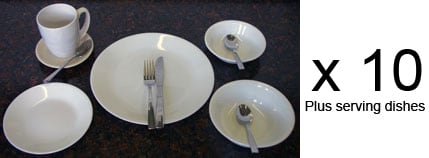
Top Rack
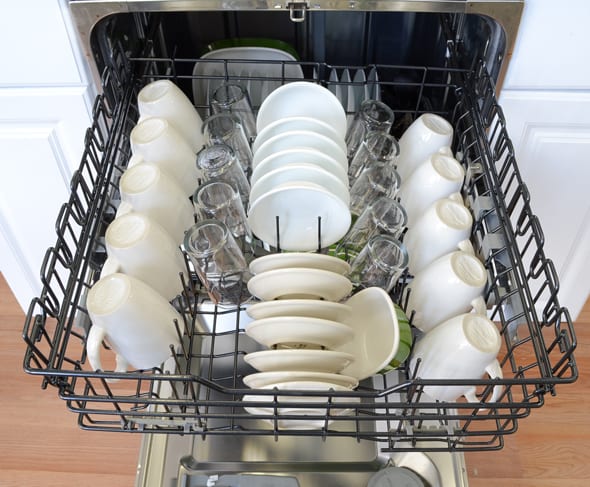
Bottom Rack
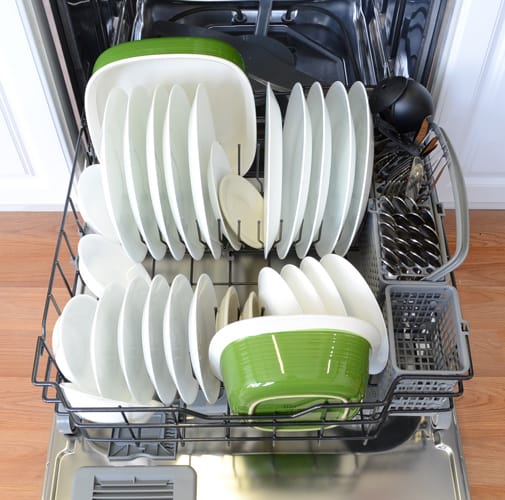
Wash Arms & Filters
{{section_header}}{{section.name}}{{/section_header}}
The wash arms are located beneath their respective dish racks. Both are made of metal, giving them a sturdier feel that’s likely to hold up over time.
The filter includes three removable components—a pipe section, a coarse filter and a fine filter. They are easily removable and seem to do a fine (pun!) job of removing grains, at least enough to forgo excessive manual cleaning.
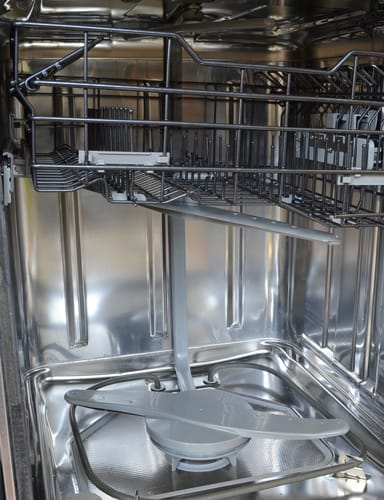
The CDWT980VSS wash arms.
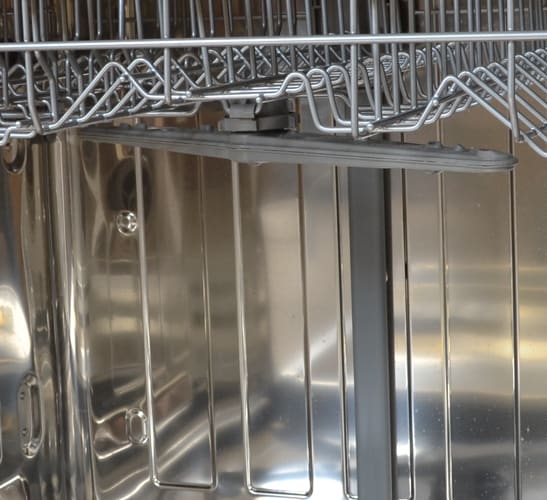
The DW 14140 upper wash arm
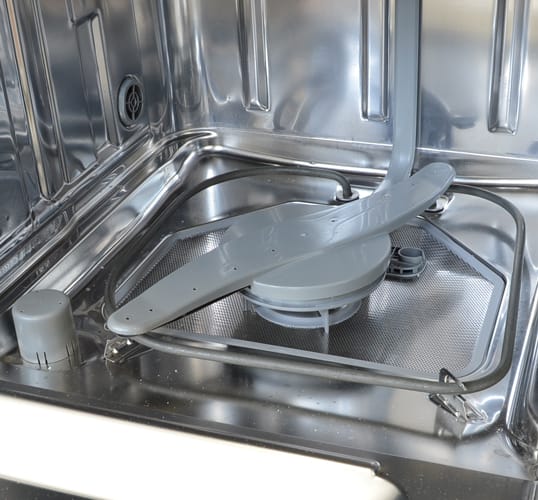
The CDWT980VSS filter.
Lower Dish Rack
{{section_header}}{{section.name}}{{/section_header}}
The two foldable rows of tines in the lower rack can be a bit of a nuisance, in that they are latched to the side of the basket and somewhat difficult to maneuver with a full load. However, their presence does make for greater flexibility. The angled tines and smoothly sliding wheels only add to this perk.

The bottom rack of the CDWT980VSS.
Upper Dish Rack
{{section_header}}{{section.name}}{{/section_header}}
The upper rack definitely seems to lack in tines, but the angled grid makes up for any lost stability. It also seems to contribute to greater dish loading flexibility, which is an interesting design strategy. Very Swedish.

The top rack of the CDWT980VSS.
Cutlery Holder
{{section_header}}{{section.name}}{{/section_header}}
The cutlery holder offers nothing by way of adjustability, but it’s certainly big enough. The handle is excessively large, but the basket slides over the tines in the bottom rack to offer enhanced maneuverability.

The CDWT980VSS cutlery basket.
Detergent Dispenser
{{section_header}}{{section.name}}{{/section_header}}
The detergent and rinse aid dispensers are very straightforward—nothing special here. The former has two lines for measuring detergent volumes, and the rinse aid container has a “max” arrow indicating the optimal amount of rinse aid. What it’s pointing at is kind of a mystery, but it’s intuitive enough.
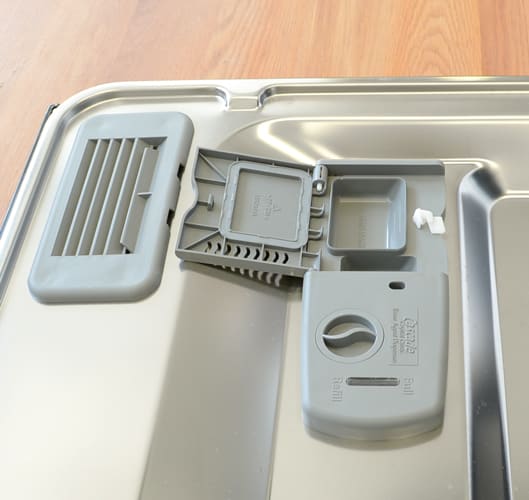
The CDWT980VSS detergent dispenser.
Ease of Use
{{section_header}}{{section.name}}{{/section_header}}
There were a few times when we scratched our heads trying to figure out the controls, but it was never to the point of exhaustion. The {{product.model}} is generally a very cool, straightforward machine, especially considering its unique design and range of extra features.
Noise
{{section_header}}{{section.name}}{{/section_header}}
Whooooosh… Whooooosh… Imagine that, on and off, for two or three hours. Does it bother you? No? Then the {{product.model}} shouldn’t be a problem, unless you sleep in your kitchen and demand silence from your appliances. To that we say, lighten up. It’s just a dishwasher.
Controls
{{section_header}}{{section.name}}{{/section_header}}
Wash cycles cannot be chosen directly; they must be scrolled through via the PROG button. The two customization buttons, as well as the Delay and Start/Stop buttons are engaged directly, but we found the latter to be somewhat weak to the touch. The few available buttons also means you have to use combinations to operate some of the extra wash options and settings, almost like mashing an attack combo in Mortal Kombat. Unfortunately, though, the {{product.model}} does not include a Fatality option.


Efficiency
{{section_header}}{{section.name}}{{/section_header}}
The {{product.model}} is highly efficient, but expect its performance on this front to diminish if you consistently engage the high-temperature or extra dry features. Remember, though, an efficient machine usually means a slower machine. But so what? Chill out.
Washing Performance
{{section_header}}{{section.name}}{{/section_header}}
Ayyy! This is where the {{product.model}} does best. All three cycles performed extremely well, even if they took their sweet old time to complete. For the sake of time and efficiency we’d recommend the Normal Wash in most cycles, but the machine is versatile enough for a variety of demands.
We also would have liked a feature where you had to give the machine a little jukebox-like whack to start it up—just like the Fonz. Think of the all the dinner guests you could impress! But we can also see why that might not be, like, you know… smart.
Features
{{section_header}}{{section.name}}{{/section_header}}
The {{product.model}} has a bunch of extra features, including two options for customizing individual washes. From an Eco Wash to a high-temperature, long dry Quick Wash, it’s tough to imagine a scenario that this dishwasher couldn’t handle.
Meet the tester
Tyler Wells Lynch is a freelance writer and journalist whose work has appeared in Vice, Wirecutter, Gizmodo, The Rumpus, Yes!, and the Huffington Post, among others. He lives in Maine.
Checking our work.
Our team is here to help you buy the best stuff and love what you own. Our writers, editors, and experts obsess over the products we cover to make sure you're confident and satisfied. Have a different opinion about something we recommend? Email us and we'll compare notes.
Shoot us an email


